Research Updates, Photos and Videos
Spotlight on Wyatt Inman: Raising Bindweed Moths in Captivity
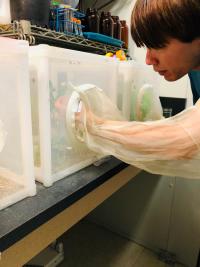 Our work with Tyta luctuosa –that involves release of the moth – required that we raise it in captivity. The insect didn’t come with rearing directions. We were fortunate in identifying an undergraduate student, Wyatt Inman, who has a long history of keeping interesting pets.
Our work with Tyta luctuosa –that involves release of the moth – required that we raise it in captivity. The insect didn’t come with rearing directions. We were fortunate in identifying an undergraduate student, Wyatt Inman, who has a long history of keeping interesting pets.
Wyatt grew up in rural Josephine County, on acreage which included the usual large mammals, but about the time he started middle school, he developed a taste for more unusual pets – exotic creatures like lizards, chinchillas, geckos, a corn snake python, and a greenbottle blue tarantula.
Wyatt started raising mealworms to feed his terrarium communities. So he came to the Tyta project with specialty experience and ideas. “In solving this problem, I started with my prior understanding of caterpillars.” Wyatt kept field-collected adult T. luctuosa in a warm room in the Department of Horticulture at Oregon State University, where they soon laid eggs. He wasn’t too worried about the temperature because they are endemic to the state. In his view, established insects found in temperate climates are likely to be more tolerant of temperature variation. Nor was he too concerned about humidity because the adults are active in the field in Oregon during the dryer part of the year.
The challenge has been in raising field bindweed, required by the larvae for development. Field bindweed does not transplant readily, and germination rates in the greenhouse have been consistently low. University farm managers have been generous in leaving healthy patches of field bindweed untouched. Caged insects in the warm room feed on wild-collected bindweed bouquets, which are provided as often as necessary.
Pupae overwintered in a growth chamber. In the spring, they were removed from growth chamber, returned to the warm room and moths emerged to begin the cycle anew.

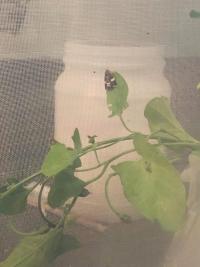

Research on Saturated Steam for Field Bindweed Management
The equipment is a gasoline-powered pump and a diesel boiler mounted on a single axel trailer. At 1 mph, the steamer converts 3.3 gallons of water to saturated steam per minute. Saturated steam is water heated to above boiling (250 °F), but held under pressure so that it remains liquid. The nozzle temperature of this steam is about 180-190 °F. Steam treatment of weeds is a time vs. speed trade-off. At this time, we recommend 1 mph with a single application delivering the equivalent of 729 gallons of steam per acre in a broadcast application; Because organic blueberries are often grown with syntethic mulches or weedmat, we are treating the portion of field next to the weedmat (about 1/3 of the field.) Research to determine optimal steam rate, or operational speed, for weed control is an emphasis of this research.
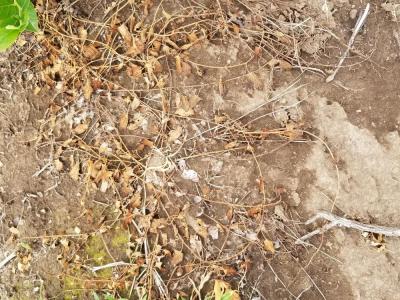
Bindweed one week after saturated steam application.
Dr. Marcelo Moretti (right) and graduate student Erik Augerson (left) demonstrated their steaming technology at the 2018 Blueberry Field Day, North Willamette Research and Extension Center, Aurora OR.
Weeds in commercial blueberry in Oregon’s Willamette are commonly managed with weed mat. However, field bindweed and other weed species can come up at the edges. Here, a medium-sized cone concentrates saturated steam at the edge of the weed mat. Steam application does not damage the mat. Cones come in a range of sizes.
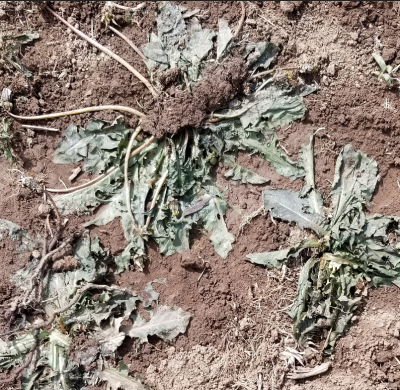
Weeds following steaming.PNG Weeds following steam treatment. Some of these, such as dandelions, will come back, because the soil protects roots from steam exposure. Annual weeds are more sensitive than perennials; any weed is more sensitive in the first year after its seed germinates.
Research on Biocontrol for Field Bindweed Management

Field bindweed regrows after application of contact herbicides. While frustrating, this may provide opportunity for timed applications of integrated management techniques.
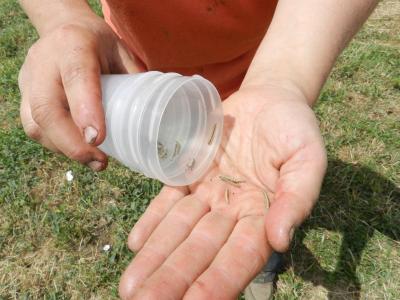
Bindweed moth larvae look similar to cutworms but have had extensive host range testing to ensure they do not feed on any plant outside of the Convolvulaceae family. This species has been a USDA-APHIS approved biocontrol agent since the early 1990’s.
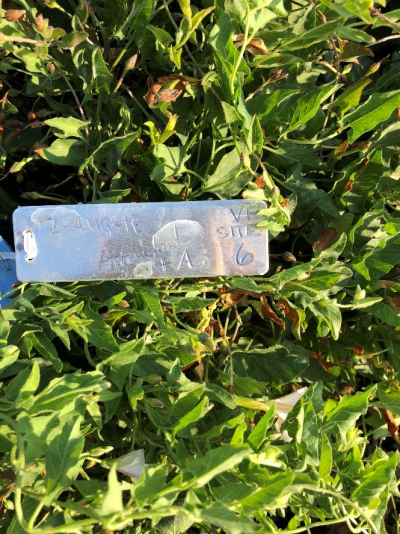
Field tests of attractant formulations will help us determine if bindweed moth herbivory can be focused, and used as a push-pull strategy.

A technician releases larvae onto a patch of bindweed in a commercial organic blueberry field. Management is particularly difficult in this setting because bindweed grows over and through weed matting.
Funding

This project was funded in 2017 by the USDA NIFA Organic Transitions grant, part of the USDA National Institute of Food and Agriculture. Grant number 2017-51106-27004
